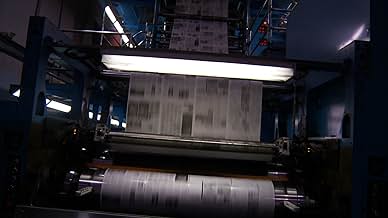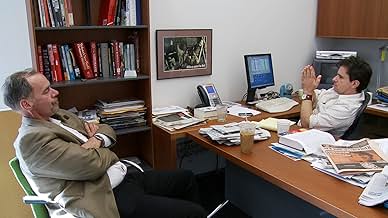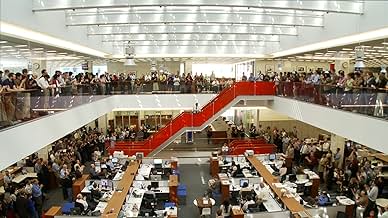Unprecedented access to the New York Times newsroom yields a complex view of the transformation of a media landscape fraught with both peril and opportunity.Unprecedented access to the New York Times newsroom yields a complex view of the transformation of a media landscape fraught with both peril and opportunity.Unprecedented access to the New York Times newsroom yields a complex view of the transformation of a media landscape fraught with both peril and opportunity.
- Awards
- 3 wins & 10 nominations total
- Director
- Writers
- All cast & crew
- Production, box office & more at IMDbPro
Featured reviews
The impact of fonts and page layouts is not just an esoteric aside. The style used for letters, characters and text are designed to create a readable, coherent and visually satisfying whole that works without the reader being aware.Where spoken language relies on tone of voice or gesture to convey emotion, the visual form of the written word possesses mysterious connotative properties. Ultimately, a world without charismatically constructed letters, numerals and symbols leads to unengaging newspapers, whether online or in print.
Joseph Y Ting
There is some argument given towards what constitutes journalism, but for me the real guts of the matter boils down to our absolute NEED for investigative reporting. I have always given value to bulldog reporting as a checks and balances for our system. Maybe, just maybe, our public officials and corporate leaders will toe the line if they are being watched. Sure, we can all rattle off a long list of when that hasn't been the case, but I truly believe, having reporters following and snooping does make a difference in the actions of those in charge ... and even if it doesn't, it certainly makes a difference in the accuracy and depth with which their actions are written about.
The filmmaker has been given substantial access to the media desk inside the newsroom. We even get to sit on a portion of the morning meeting where the senior editors decide what the lead stories will be. Personally, I would have loved a couple more hours of just that! But just as fascinating is how Bruce Headlam manages the media news, and in particular, star reporter David Carr. Mr. Carr is a hardened reporter with the spectacular ability to cut directly through to the important point and focus on the details, verify those details, and then summarize in a concise, understandable manner. We see this in full beauty with his handling of the crisis and scandal at the Chicago Tribune under Sam Zell's banner.
Today, we like our news spoon fed to us in 20 second sound bites. So we find our favorite websites and we scan the headlines, which themselves are scans of news stories. My favorite moment of the movie occurs on a discussion panel when David Carr holds up a printout of the home page of an "aggregator". Moments later he makes the point that without real reporters and news teams (like the NYT), this aggregator's home page would look quite different ... he then holds up that same home page with 90% of the stories cut out because their source is a real news organization.
Some attention is paid to Twitter and other social media outlets. This seems to be finally accepted by the reporters as being effective for two things: a delivery system for information and a grapevine with lightning speed. Of course, no verification is required for a "news" story to hit Twitter, and therein lies its limitation.
We get interviews from both Gay Talese and Carl Bernstein on the importance of news reporting. Evidence is provided through mentions of the Pentagon Papers, Wikileaks and Watergate. Judith Miller and Jayson Blair are topics that embarrassed and did significant damage to the industry ... but changes were adopted to (hopefully) prevent re occurrence. The News of the World scandal is too new to have made the film, but it certainly would have added a fascinating subtext to it.
The bankruptcy trail of so many newspapers is discussed, along with the possibility of this happening at The Times. Personally I wish more detail had been provided on the survival strategy of this institution. Since the release of the film, there has been a change in the Executive Editor position. Bill Keller, who is featured prominently in the morning meetings, has stepped down and been replaced by Jill Abramson. Ms. Abramson is charged with driving and building online presence and revenue. We should all be wishing her success as the world is a better place with The New York Times.
The digital revolution , internet, etc have started to compete with printed media such as the legendary newspaper The New York Times, a newspaper that is depicted in this documentary.
We get follow some of their reporters, the job at the editing office, and also the new approach to the internet and surfpads.
But will The New York Times be able to compete with websites like Wikileaks etc?
And how will they survive in climate with ever descending ad incomes?
Will the internet completely destroy investigating journalism?
Because nowadays anyone can be investigating journalist by simply putting their discoveries on a personal blog or any other type of internetbased platform.
These and many other questions are discussed in this highly interesting documentary about media from one of the most prominent newspapers in the world.
The documentary also touches upon the heavy criticisms that newspaper received during the Judith Miller, Jayson Blair scandals and ever growing question, can we trust media at all?
The only flaws I can think of is that sometimes director Andrew Rossi seem to lack focus, not knowing what he wants to tell, he should made the viewers get closer to some of the people working at the New York Times.
I would love to know more about David Carrs background, a colourful journalist, and some of his co workers background.
But this film should been seen by anyone wanting to know more about media, journalism in this riveting documentary. So viewers who liked Outfoxed: Rupert Murdoch's War on Journalism (2004), The Most Dangerous Man in America: Daniel Ellsberg and the Pentagon Papers (2009), Starsuckers (2009) should see this one.
Too bad for the film's audience though, David Carr comes across as more of an a**hole for most of the film and you welcome to other locales and issues the documentary focuses on when it's not on Carr. There are scenes of employee layoffs, contrite apologies about Judith Miller and Jayson Blair, and the continuing defense that without the large, networked mainstream media, these new social media / news aggregator sites would have nothing to link to on their websites. These professional at-home bloggers do not have bureaus in Baghdad, stringers in war zones, and in an amusing side bit, they do not have people following their hometown zoning boards either.
Page One is effective at showing the audience that hardcopy newspapers are not dead yet and they still provide a considerable service to those who wish to remain informed. Regrettably, the film spends way too much time on David Carr and the media section which bogs down the film and makes the audience wait for the next segment not involving Carr.
This story is told primarily from the perspective of the staff on the media desk; editor Bruce Headlam, columnist David Carr and correspondent Brian Stelter. These are the guys in the unenviable position of reporting on (amongst other things) the bankruptcy of other newspapers caused by the growth of online news and the drop in advertising and circulation revenues. Carr in particular gets most of the screen time, and deservedly so. He is a profane and fiercely intelligent presence with a back-story worthy of Hollywood itself, while Stelter is that unique case of someone who started out as an anonymous news blogger before moving over to print media. After outing his identity in a series of stories about his site, the Times then went and offered him a job. He is one of the new breed – a journalist who embraces the advantages of developing technology. He is seen at his cubicle with several computers running, tweeting about his stories, even bringing in a brand new iPad to demonstrate to his dumbfounded old-school colleagues.
Rossi spent a year in the Times newsroom and the film covers a variety of stories and issues covered by the paper in that time, including the Iraq War; Carr's piece on the bankruptcy of the Tribune Company (which he linked directly to mismanagement by its new owner Sam Zell and his executives); and the explosion of Wikileaks into the public consciousness with their publication of the Afghan War logs. This last is also compared to the similar case of the infamous Pentagon Papers leak in 1971 by Daniel Ellsberg to the Times. The advances in the internet have essentially done away with the idea of a Deep Throat. No longer will an insider source need to work with a reporter. Now they can just go online and tell their tale to everyone. While this means that "the truth will out" so much more, it also takes away that important middle step of fact-checking, confirming and crafting a story that a properly trained and respected journalist provides.
In its examination of the slowly dwindling print business, this film covers similar territory to the final season of The Wire. David Simon built the conclusion of his opus around a somewhat fictionalised version of his own former haunt, the Baltimore Sun. Simon features in this movie briefly as well, in a short clip of a televised debate on the dying art of a reporter working a beat that also included Arianna Huffington of the all-conquering Huffington Post. He raises a very solid point though: even with everyone and his wife blogging the news from their bedrooms, there will always be a place for the reporter on the scene, notebook in hand. The delivery method may change with the times (pardon the pun) but the infrastructure, methods and ethics of the newspaper will always be necessary. The "more with less" evangelists are having their day in the sun, but hopefully a new day will dawn soon enough. The best way to make sure that happens is to accept the fact that news costs. The film touches on the idea of pay-walls on the online versions of the paper. I'm all for these personally. You have to pay for the physical newspaper, why shouldn't you pay for the digital version?
It's rare that I get to say this, but all the poster quotes are true. This is a fascinating film that covers a lot of ground in only 92 minutes. Now if you'll excuse me, I'm off to buy my online subscription to the New York Times.
Did you know
- Quotes
Shane Smith: I'm a regular guy and I go to these places and I go, "OK, everyone talked to me about cannibalism, right? Everyone talked about cannibalism." Now I'm getting a lot of shit for talking about cannibalism. Whatever. Everyone talked to me about cannibalism! That's fucking crazy! So the actual... our audience goes, 'That's fucking insane, like, that's nuts!' The New York Times, meanwhile, is writing about surfing, and I'm sitting there going like, 'You know what? I'm not going to talk about surfing, I'm going to talk about cannibalism, because that fucks me up.'
David Carr: Just a sec. Time out. Before you ever went there, we've had reporters there reporting on genocide after genocide. Just because you put on a fucking safari helmet and looked at some poop doesn't give you the right to insult what we do. So, continue.
- ConnectionsFeatured in De wereld draait door: Episode #6.173 (2011)
- SoundtracksLost in Detroit
Written and performed by Rolfe Kent
From the motion picture In the Air (2009)
Courtesy of Paramount Pictures
Details
- Release date
- Country of origin
- Official sites
- Language
- Also known as
- Page One: Inside the New York Times
- Production companies
- See more company credits at IMDbPro
Box office
- Gross US & Canada
- $1,067,028
- Opening weekend US & Canada
- $28,911
- Jun 19, 2011
- Gross worldwide
- $1,077,982
- Runtime
- 1h 32m(92 min)
- Color
- Sound mix


















